O'Dell
Paul Fredrick O'Dell
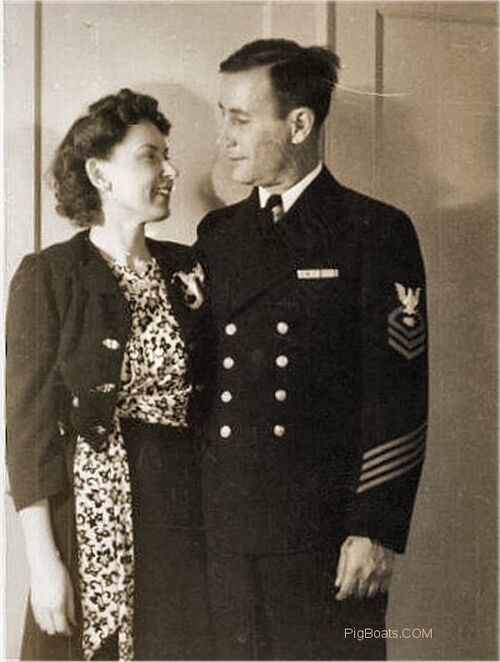
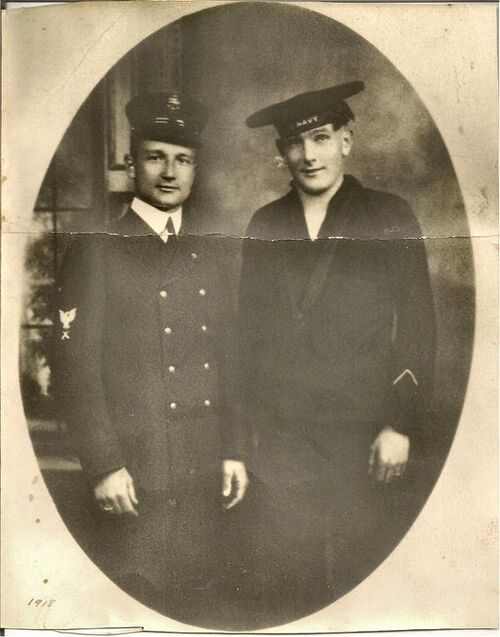
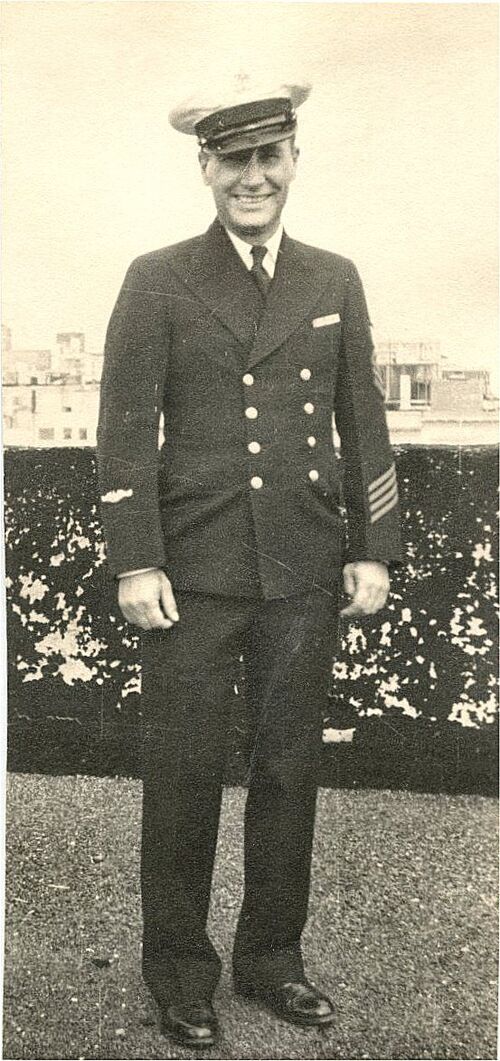
Paul Fredrick O'Dell was born January 2, 1906 in Joplin, Missouri to parents John Lafayette Odell (1872 –1913) and Mary Etta 'Mamie' Fitzgerald Kelin (1877 – 1955). Paul was the third of five children. Second oldest brother, Howard H. Odell, born in February of 1903, died at age six months on July 14, 1903. The family lived on Park View Avenue in Joplin City, MO.
Oldest brother, James Gillespie O'Dell (1897 – 1970) had joined the Navy and was Chief Gunners Mate when Paul joined the Navy. There is a family photo of the two together, though it is obvious that the uniform Paul is wearing is his brothers since the uniform has a WW I area of service chevron on the left arm and Paul wasn't in the navy until 1927.
Two younger brothers were Garland Wilbur O'Dell Sr (1909 –1982) and Charles Clinton O'Dell (1913 –1981).
Father, John, is listed as an 'Engineer' in the 1910 US Census but what kind isn't clearly written. It appears to say 'Stationary Engineer'. He may have worked in a power plant or major building or hospital on any verity of equipment. John died in 1913 at age 41.
With the passing of John O'Dell and the family income, the family moved into 'lodgings' at 724 Moffet Avenue in Joplin City. Oldest brother James is now working as an automotive electrician and on battery systems. His wife, Florence, mother Mary Etta and three remaining brothers are all listed as “Roomers' in the 1920 census at the same address. Paul is 14 years old and he has dropped out of school and is working as a 'Laborer', actually he is specifically a grease monkey, maybe at the shop where his older brother is employed.
In 1924 he married Lina Spencer who was also born in 1906. The marriage lasted only a few years and the couple divorced. In 1929 she married to John F Gray. She divorced him in 1940.
Someplace in this scenario James joins the Navy and becomes, by 1927, a Chief Gunners Mate. Little more about his service is known.
On August 3, 1927 a 21 year old Paul enlists in the Navy. After boot camp Paul is sent to the battleship USS Tennessee, BB-43 for duty with the ship in the Pacific. The Tennessee was home ported out of San Pedro, California. It isn't known if he had decided to become a Radioman at this time or not.
After a year or so he is transferred to the submarine tender USS Argonne AS-10 which operated out of San Diego, California. This maybe where Paul gets his first taste of submarine life because by 1929 he has been transferred to the USS S-43.
It isn't known if he attended submarine school or not since the S-43 was a Pacific coast based submarine operating out of San Diego. Paul was aboard for exercises and fleet problems off southern California that were followed by summer operations in Hawaiian waters and autumn patrols and exercises off Mexico. In December of 1930 the S-43 and Paul were reassigned to Pearl Harbor where he remained until 1932.
Paul transferred to the USS S-1, that was also stationed at Pearl Harbor in 1932. In August of 1933 the S-1 was transferred to Philadelphia for decommissioning. Paul was transferred to the USS S-36 that was at that time operating in the western Pacific, conducting exercises and patrols and undergoing overhauls in the Philippines during the winter and operating off the China coast, out of Tsingtao, during the summer months.
Information says that he was stationed at Cavite in the Philippines during 1934 and 1935 but not if he was attached to a submarine or not. On the 25th of May 1935 Paul reenlisted at Cavite. Come 1936 we find him aboard the USS Bass SS-164 that was conducting cruises along the west coast of the United States, in the Canal Zone, and in the Hawaiian Islands until January 1937 when she was ordered to Philadelphia for decommissioning.
He married Dorothy Viola Summers in 1937 and they remained married to the end.
He was transferred to the USS Pickerel SS-177 that had been conducting training exercises along the US Pacific Coast before being transferred to the Philippines in anticipation of possible hostilities that that area.
He reported aboard the USS Porpoise SS-172 on December 5, 1938. By 1939 he has become a Radioman 2/class while she was undergoing an extensive overhaul at Mare Island Navy Yard. Here he extended his enlistment by 3 years. He must have been unhappy in the yard and was on the go again. This time aboard the USS Chaumont AP-5 heading back to Asiatic Station. The Chaumont was more or less operating as a ferry moving military and politicians around the Pacific.
Upon reaching Asiatic Station he was attached to the USS S-41 on September 2, 1939 that was conducting operations along the China coast, the Philippines and in the East Indies. He was promoted to Radioman 1/Class in October 1939. In December of 1939 he became ill and was transferred to the US Naval Hospital at Canacao, Philippines for treatment.
He was transferred, again, in August 1940. This time to the submarine tender USS Canopus AS-9.
By December 1940 he is aboard the USS Permit SS-178 but once again he transferred to the US Naval Hospital at Canacao, Philippines for treatment of an undisclosed illness.
In June of 1941 Paul has been sent to the Navy transport USS Henderson AP-1 headed for Guam and then Pearl Harbor and finally to Mare Island to the Navy Hospital. Something is seriously wrong but we don't know what it is.
August 22, 1941 has Paul in the US Naval Hospital at Mare Island and being released to the Navy Receiving Ship at San Francisco where in October 1941 he was put aboard the aircraft carrier USS Lexington CV-2 for a trip from San Francisco to San Diego.
In San Diego he was sent to the old 4 piper USS Chew DD-106 for transportation to Pearl Harbor. He was to remain aboard the Chew for the next year.
In March 1942 he was promoted to Chief Radioman (Acting) while aboard the Chew so he must have still been able to operate in rate and pass testing to satisfy the Navy.
In June of 1942 he went back to the hospital for more treatment for his mysterious illness and then again in December he is again at the US Naval Hospital at Pearl Harbor. Finally on January 15, 1943 he is transferred back to the USS Chew from the Hospital at Pearl Harbor.
In mid 1943 he received orders to new construction at Electric Boat Company in Groton, Connecticut and the USS Dorado. The Dorado was commissioned on August 28, 1943. All trace of the Dorado disappears after her sailing.
The following information is from Wikipedia and the Dictionary of American Naval Fighting Ships:
After she sailed from New London, Connecticut, on 6 October 1943 for the Panama Canal Zone. She did not arrive.
The standard practice of imposing bombing restrictions within an area 50 nautical miles (nmi) ahead, 100 nmi astern, and 15 nmi on each side of the scheduled position of an unescorted submarine making passage in friendly waters had been carried out and all concerned had been notified. However, the crew of a PBM Mariner of Patrol Squadron 210 out of Guantanamo Bay, Cuba, assigned to provide air coverage on the evening of 12 October had received an incorrect description of the restriction area, 11 nmi out of place.
At 2049 local time, under a moon-lit but stormy sky, that plane attacked an unidentified submarine that it believed was outside the restriction area with three Mark-47 depth charges and a 100 lb Mark-4 Mod-4 demolition bomb. About two hours later, the plane sighted a second submarine with which it attempted to exchange recognition signals. This second submarine fired upon the plane. A convoy scheduled to pass through the restricted area surrounding Dorado on the evening of 12 October reported no contact.
Air searches were begun immediately after 14 October, her scheduled date of arrival. Widely scattered oil slicks with occasional debris were found. Subsequently the Board of Investigation held in Guantanamo Bay, and the more formal Naval Board of Inquiry held at the Washington Navy Yard, found that the 'widely scattered oil slicks' were actually 'oleous' in nature and not bunker oil or fuel - most probably rotting vegetation like seaweed. All of the 'occasional debris' was determined not to have come from Dorado.
At both the Board of Investigation and the Court of Inquiry, the aircrew testified that they were certain that both submarines they had attacked were U-boats. Despite the circumstantial evidence, there are reasons to doubt that Dorado was sunk by the Mariner. Because the crew knew that Dorado was operating in the area, they carefully observed their two targets before attacking. Prior to the first attack, the four crewmen of the aircraft observed the surfaced submarine for 12 minutes, noting:
- it was 48 nmi from where they had been told to expect Dorado to be and 34 nmi from where Dorado really was supposed to be
- it was heading almost 90 degrees off from Dorado’s base course
- it had no guns on the fore deck where Dorado carried a five-inch gun
- it had an entirely grooved deck where Dorado's deck was grooved only near the conning tower
- it had a 'knob-like' object on the front of the conning tower, almost certainly the Biscay Cross radar detector installed on Type IX U-boats FuMB-1 Metox-U-boat radar detector antenna, similar to the Biscay Cross.
Post-war examination of Kriegsmarine records indicate that the submarine first attacked by the Mariner may have been U-518, though that boat's logs do not record the attack. It is possible that the attack went unnoticed by the boat; of the three depth charges and one 100 pound bomb that were dropped, one depth charge was a confirmed dud, one was dropped too low to arm, and neither the third depth charge nor the bomb were seen to explode. After the attack, the Mariner searched the area for 20 minutes, but saw no explosions, bubbles, or debris.
The second submarine, attacked by the Mariner two hours later, was certainly U-214; her log book, captured after World War II, describes firing at the aircraft. On 8 October, five miles off Colon, U-214 laid a minefield of 15 mines. One of these may have sunk the United States Navy submarine USS Dorado SS-248 on or about 14 October 1943. All 78 hands presumed lost.
Paul Fredrick O'Dell was 37 years of age when Dorado was lost. Widow Dorothy O'Dell we believe died in 1975. It is much harder to trace women due to name changes. We can find no mention of children.
Photo of Paul and wife Dorothy in the Private Collection of Ric Hedman.
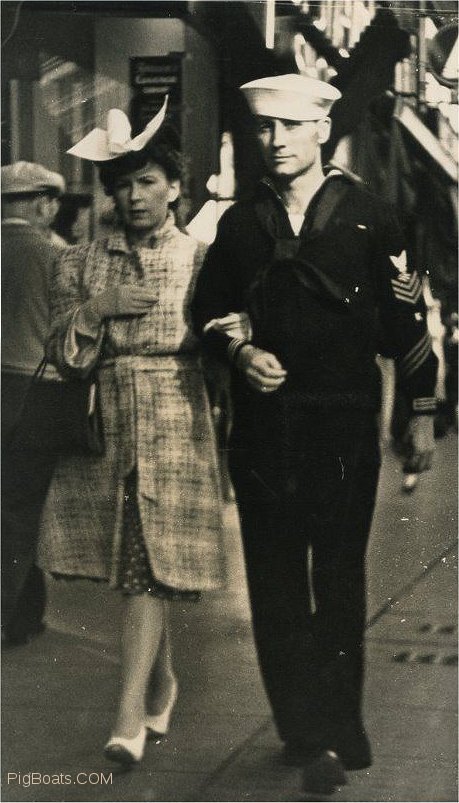
Paul O'Dell with wife Dorothy walking down a street in either San Francisco or maybe San Diego in the fall of 1941 after his stay at the Navy Hospital at Mare Island. He is still a 1st/Class Radioman.
At this time street photographers would take peoples pictures and then sell them prints. This is obviously a very candid shot and not posed. Paul was a sharp dressed sailor with an attractive lady on his arm and was showing off.
Photo in the Private Collection of Ric Hedman
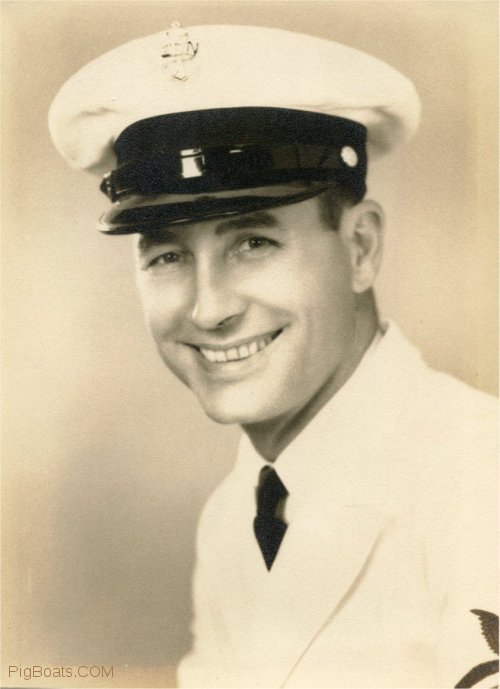
Paul O'Dell photographed in his summer white uniform. Photo could have been taken in Hawaii in 1942, where whites are the norm year around or perhaps in the summer of 1943 while attached to new construction for the USS Dorado SS 248.
Photo in the Private Collection of Ric Hedman
Page created by:
Ric Hedman & David Johnston
1999 - 2023 - PigBoats.COM©
Mountlake Terrace, WA, Norfolk, VA
webmaster at pigboats dot com
